HRM6006: Analyzing Employee Turnover & Retention - HRM Strategies
VerifiedAdded on 2023/06/03
|17
|3845
|173
Report
AI Summary
This report examines the critical aspects of managing human resources, focusing on employee retention strategies. It begins with a literature review exploring reasons for employee turnover, such as job dissatisfaction, lack of training, poor relationships with managers, limited growth opportunities, and work-life balance issues. The report analyzes theories like Herzberg's motivation-hygiene theory and discusses tools like employee surveys and exit interviews for gathering insights. Findings highlight that employees often leave due to lack of opportunity, leadership dissatisfaction, and the need for challenging environments. The report concludes by recommending strategies for improving retention, including manager involvement, open communication, financial rewards, and creating a supportive work environment where employees feel valued and have opportunities for growth. This document is available on Desklib, a platform offering a wealth of academic resources for students.

Managing the Human
Resource
Managing the Human resource
Resource
Managing the Human resource
Paraphrase This Document
Need a fresh take? Get an instant paraphrase of this document with our AI Paraphraser
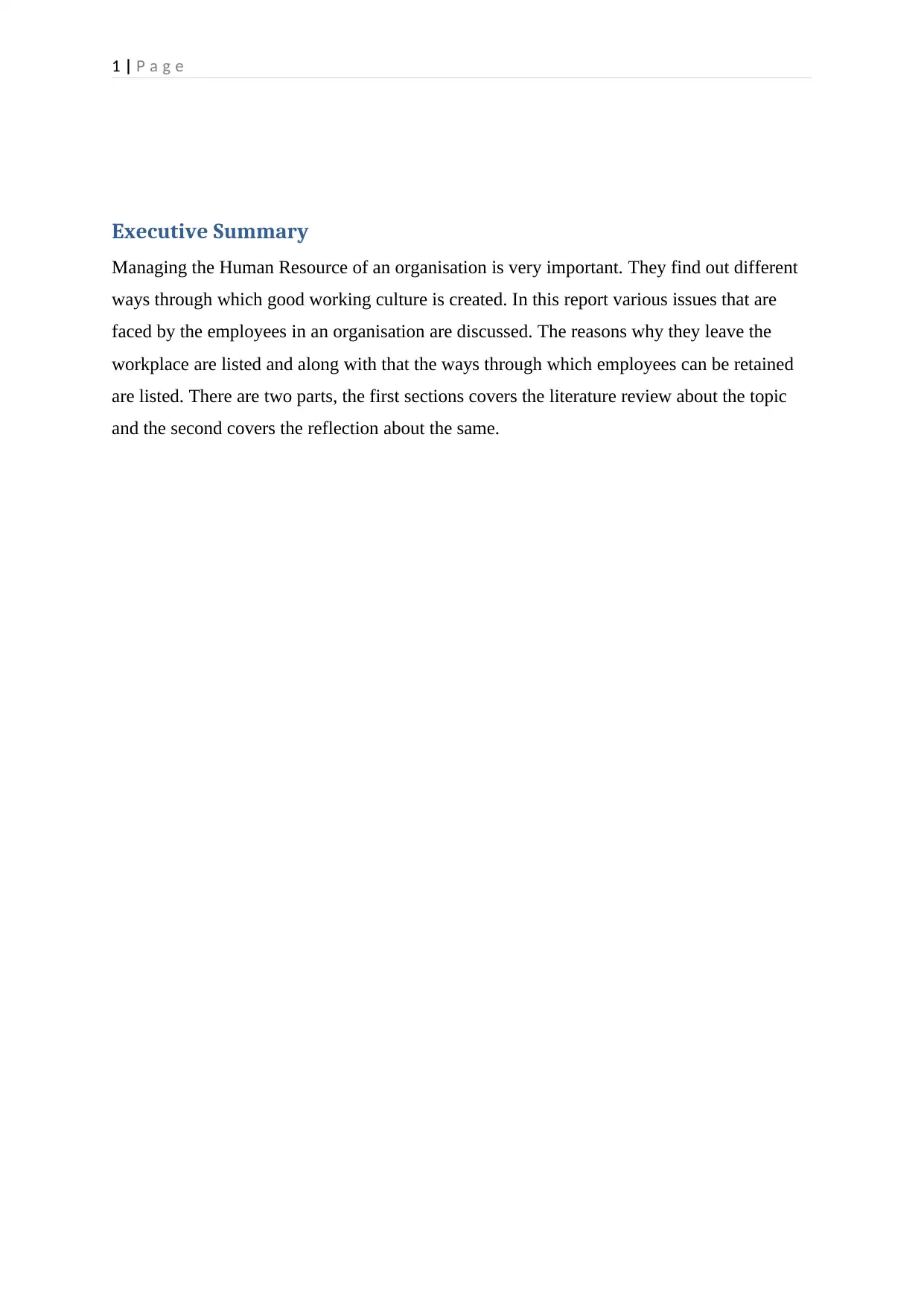
1 | P a g e
Executive Summary
Managing the Human Resource of an organisation is very important. They find out different
ways through which good working culture is created. In this report various issues that are
faced by the employees in an organisation are discussed. The reasons why they leave the
workplace are listed and along with that the ways through which employees can be retained
are listed. There are two parts, the first sections covers the literature review about the topic
and the second covers the reflection about the same.
Executive Summary
Managing the Human Resource of an organisation is very important. They find out different
ways through which good working culture is created. In this report various issues that are
faced by the employees in an organisation are discussed. The reasons why they leave the
workplace are listed and along with that the ways through which employees can be retained
are listed. There are two parts, the first sections covers the literature review about the topic
and the second covers the reflection about the same.
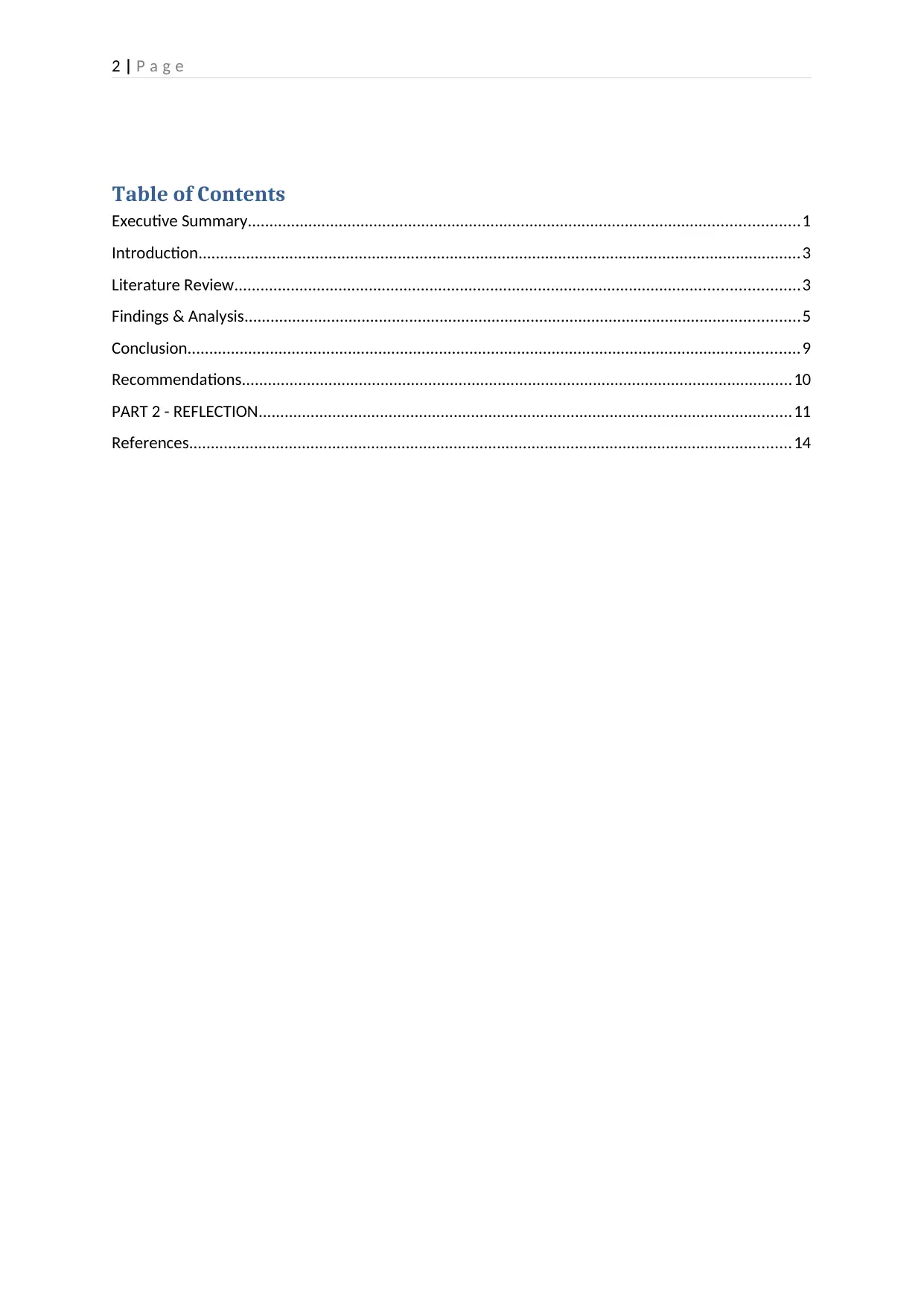
2 | P a g e
Table of Contents
Executive Summary...............................................................................................................................1
Introduction...........................................................................................................................................3
Literature Review..................................................................................................................................3
Findings & Analysis................................................................................................................................5
Conclusion.............................................................................................................................................9
Recommendations...............................................................................................................................10
PART 2 - REFLECTION...........................................................................................................................11
References...........................................................................................................................................14
Table of Contents
Executive Summary...............................................................................................................................1
Introduction...........................................................................................................................................3
Literature Review..................................................................................................................................3
Findings & Analysis................................................................................................................................5
Conclusion.............................................................................................................................................9
Recommendations...............................................................................................................................10
PART 2 - REFLECTION...........................................................................................................................11
References...........................................................................................................................................14
⊘ This is a preview!⊘
Do you want full access?
Subscribe today to unlock all pages.

Trusted by 1+ million students worldwide
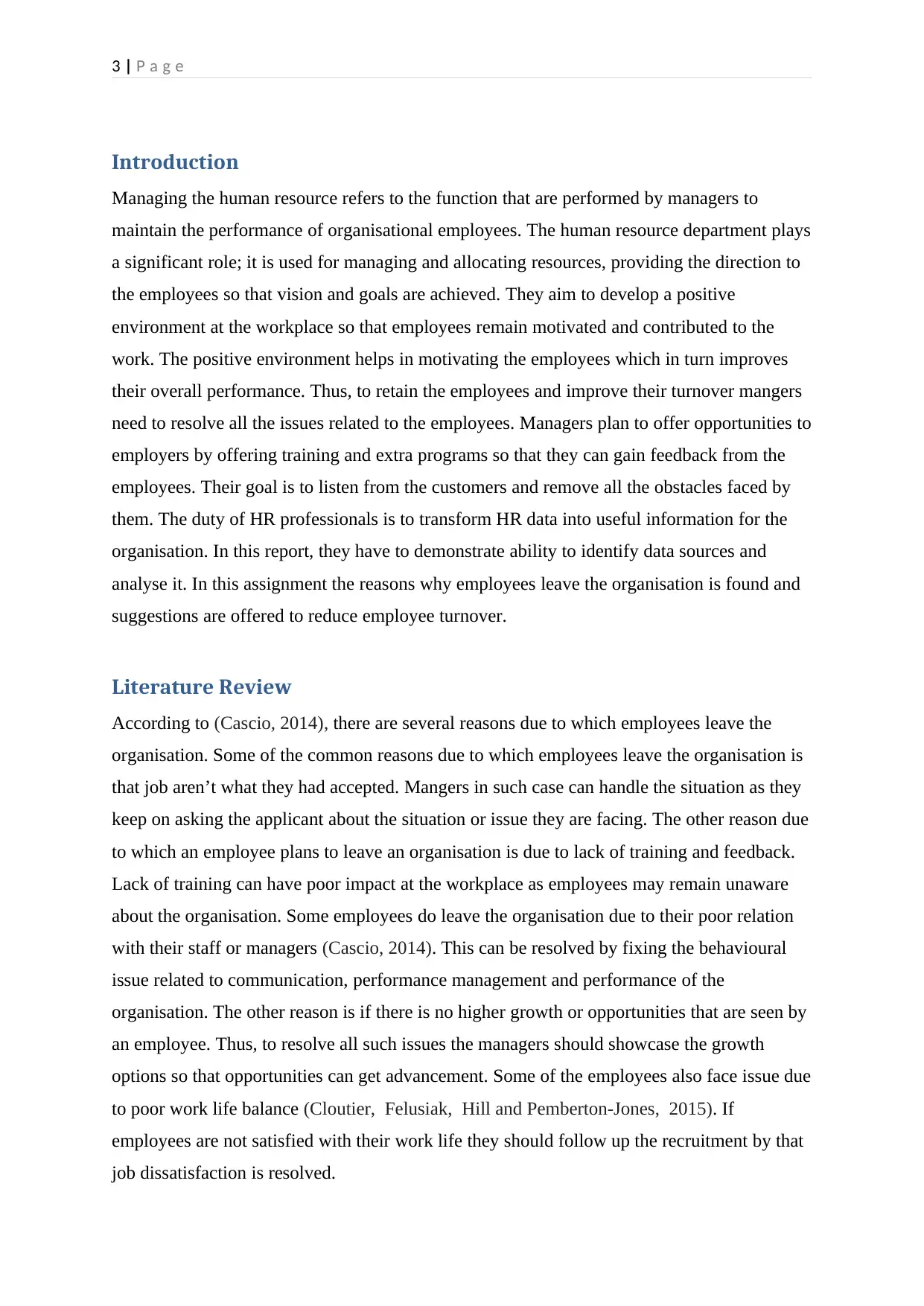
3 | P a g e
Introduction
Managing the human resource refers to the function that are performed by managers to
maintain the performance of organisational employees. The human resource department plays
a significant role; it is used for managing and allocating resources, providing the direction to
the employees so that vision and goals are achieved. They aim to develop a positive
environment at the workplace so that employees remain motivated and contributed to the
work. The positive environment helps in motivating the employees which in turn improves
their overall performance. Thus, to retain the employees and improve their turnover mangers
need to resolve all the issues related to the employees. Managers plan to offer opportunities to
employers by offering training and extra programs so that they can gain feedback from the
employees. Their goal is to listen from the customers and remove all the obstacles faced by
them. The duty of HR professionals is to transform HR data into useful information for the
organisation. In this report, they have to demonstrate ability to identify data sources and
analyse it. In this assignment the reasons why employees leave the organisation is found and
suggestions are offered to reduce employee turnover.
Literature Review
According to (Cascio, 2014), there are several reasons due to which employees leave the
organisation. Some of the common reasons due to which employees leave the organisation is
that job aren’t what they had accepted. Mangers in such case can handle the situation as they
keep on asking the applicant about the situation or issue they are facing. The other reason due
to which an employee plans to leave an organisation is due to lack of training and feedback.
Lack of training can have poor impact at the workplace as employees may remain unaware
about the organisation. Some employees do leave the organisation due to their poor relation
with their staff or managers (Cascio, 2014). This can be resolved by fixing the behavioural
issue related to communication, performance management and performance of the
organisation. The other reason is if there is no higher growth or opportunities that are seen by
an employee. Thus, to resolve all such issues the managers should showcase the growth
options so that opportunities can get advancement. Some of the employees also face issue due
to poor work life balance (Cloutier, Felusiak, Hill and Pemberton-Jones, 2015). If
employees are not satisfied with their work life they should follow up the recruitment by that
job dissatisfaction is resolved.
Introduction
Managing the human resource refers to the function that are performed by managers to
maintain the performance of organisational employees. The human resource department plays
a significant role; it is used for managing and allocating resources, providing the direction to
the employees so that vision and goals are achieved. They aim to develop a positive
environment at the workplace so that employees remain motivated and contributed to the
work. The positive environment helps in motivating the employees which in turn improves
their overall performance. Thus, to retain the employees and improve their turnover mangers
need to resolve all the issues related to the employees. Managers plan to offer opportunities to
employers by offering training and extra programs so that they can gain feedback from the
employees. Their goal is to listen from the customers and remove all the obstacles faced by
them. The duty of HR professionals is to transform HR data into useful information for the
organisation. In this report, they have to demonstrate ability to identify data sources and
analyse it. In this assignment the reasons why employees leave the organisation is found and
suggestions are offered to reduce employee turnover.
Literature Review
According to (Cascio, 2014), there are several reasons due to which employees leave the
organisation. Some of the common reasons due to which employees leave the organisation is
that job aren’t what they had accepted. Mangers in such case can handle the situation as they
keep on asking the applicant about the situation or issue they are facing. The other reason due
to which an employee plans to leave an organisation is due to lack of training and feedback.
Lack of training can have poor impact at the workplace as employees may remain unaware
about the organisation. Some employees do leave the organisation due to their poor relation
with their staff or managers (Cascio, 2014). This can be resolved by fixing the behavioural
issue related to communication, performance management and performance of the
organisation. The other reason is if there is no higher growth or opportunities that are seen by
an employee. Thus, to resolve all such issues the managers should showcase the growth
options so that opportunities can get advancement. Some of the employees also face issue due
to poor work life balance (Cloutier, Felusiak, Hill and Pemberton-Jones, 2015). If
employees are not satisfied with their work life they should follow up the recruitment by that
job dissatisfaction is resolved.
Paraphrase This Document
Need a fresh take? Get an instant paraphrase of this document with our AI Paraphraser
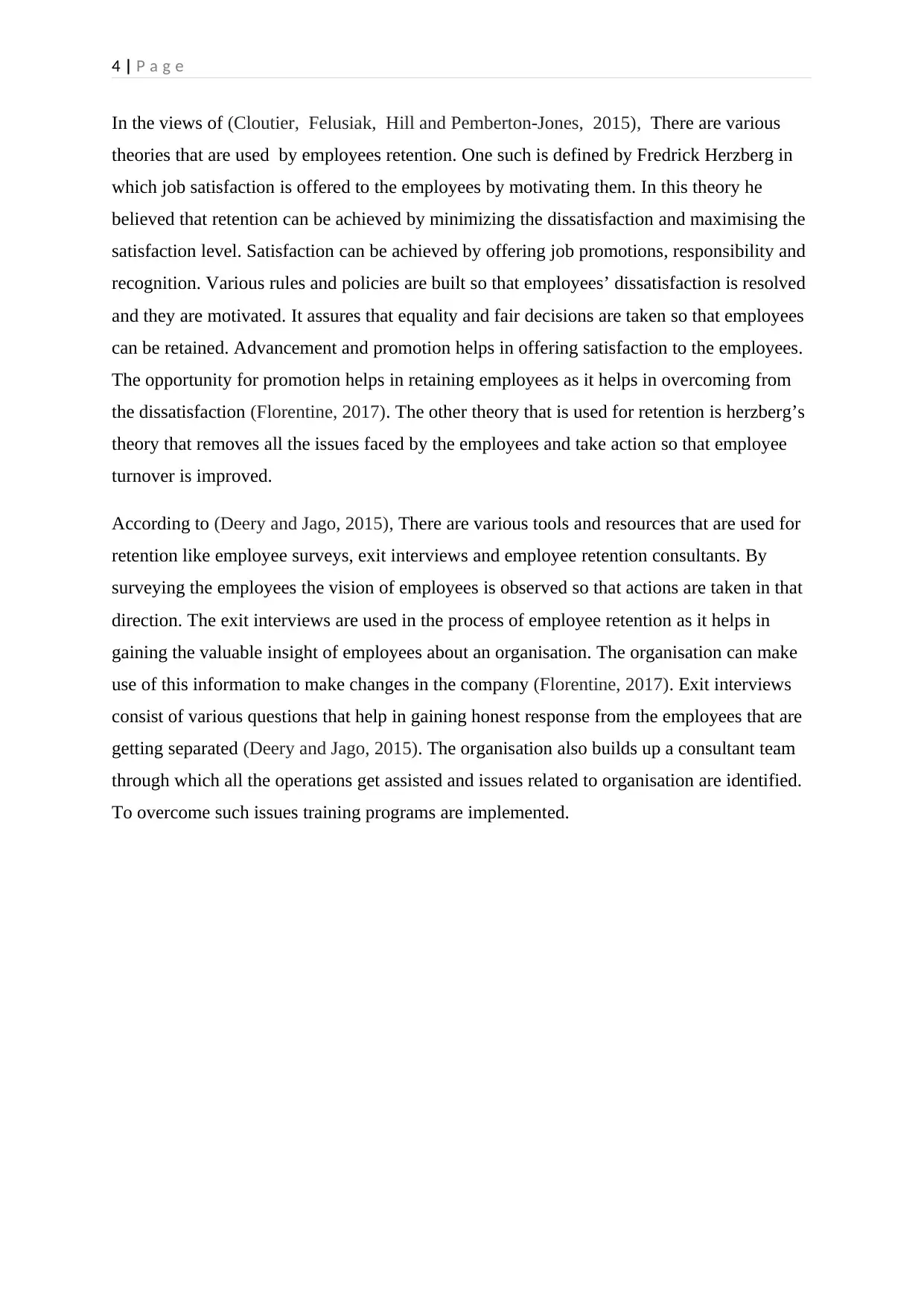
4 | P a g e
In the views of (Cloutier, Felusiak, Hill and Pemberton-Jones, 2015), There are various
theories that are used by employees retention. One such is defined by Fredrick Herzberg in
which job satisfaction is offered to the employees by motivating them. In this theory he
believed that retention can be achieved by minimizing the dissatisfaction and maximising the
satisfaction level. Satisfaction can be achieved by offering job promotions, responsibility and
recognition. Various rules and policies are built so that employees’ dissatisfaction is resolved
and they are motivated. It assures that equality and fair decisions are taken so that employees
can be retained. Advancement and promotion helps in offering satisfaction to the employees.
The opportunity for promotion helps in retaining employees as it helps in overcoming from
the dissatisfaction (Florentine, 2017). The other theory that is used for retention is herzberg’s
theory that removes all the issues faced by the employees and take action so that employee
turnover is improved.
According to (Deery and Jago, 2015), There are various tools and resources that are used for
retention like employee surveys, exit interviews and employee retention consultants. By
surveying the employees the vision of employees is observed so that actions are taken in that
direction. The exit interviews are used in the process of employee retention as it helps in
gaining the valuable insight of employees about an organisation. The organisation can make
use of this information to make changes in the company (Florentine, 2017). Exit interviews
consist of various questions that help in gaining honest response from the employees that are
getting separated (Deery and Jago, 2015). The organisation also builds up a consultant team
through which all the operations get assisted and issues related to organisation are identified.
To overcome such issues training programs are implemented.
In the views of (Cloutier, Felusiak, Hill and Pemberton-Jones, 2015), There are various
theories that are used by employees retention. One such is defined by Fredrick Herzberg in
which job satisfaction is offered to the employees by motivating them. In this theory he
believed that retention can be achieved by minimizing the dissatisfaction and maximising the
satisfaction level. Satisfaction can be achieved by offering job promotions, responsibility and
recognition. Various rules and policies are built so that employees’ dissatisfaction is resolved
and they are motivated. It assures that equality and fair decisions are taken so that employees
can be retained. Advancement and promotion helps in offering satisfaction to the employees.
The opportunity for promotion helps in retaining employees as it helps in overcoming from
the dissatisfaction (Florentine, 2017). The other theory that is used for retention is herzberg’s
theory that removes all the issues faced by the employees and take action so that employee
turnover is improved.
According to (Deery and Jago, 2015), There are various tools and resources that are used for
retention like employee surveys, exit interviews and employee retention consultants. By
surveying the employees the vision of employees is observed so that actions are taken in that
direction. The exit interviews are used in the process of employee retention as it helps in
gaining the valuable insight of employees about an organisation. The organisation can make
use of this information to make changes in the company (Florentine, 2017). Exit interviews
consist of various questions that help in gaining honest response from the employees that are
getting separated (Deery and Jago, 2015). The organisation also builds up a consultant team
through which all the operations get assisted and issues related to organisation are identified.
To overcome such issues training programs are implemented.
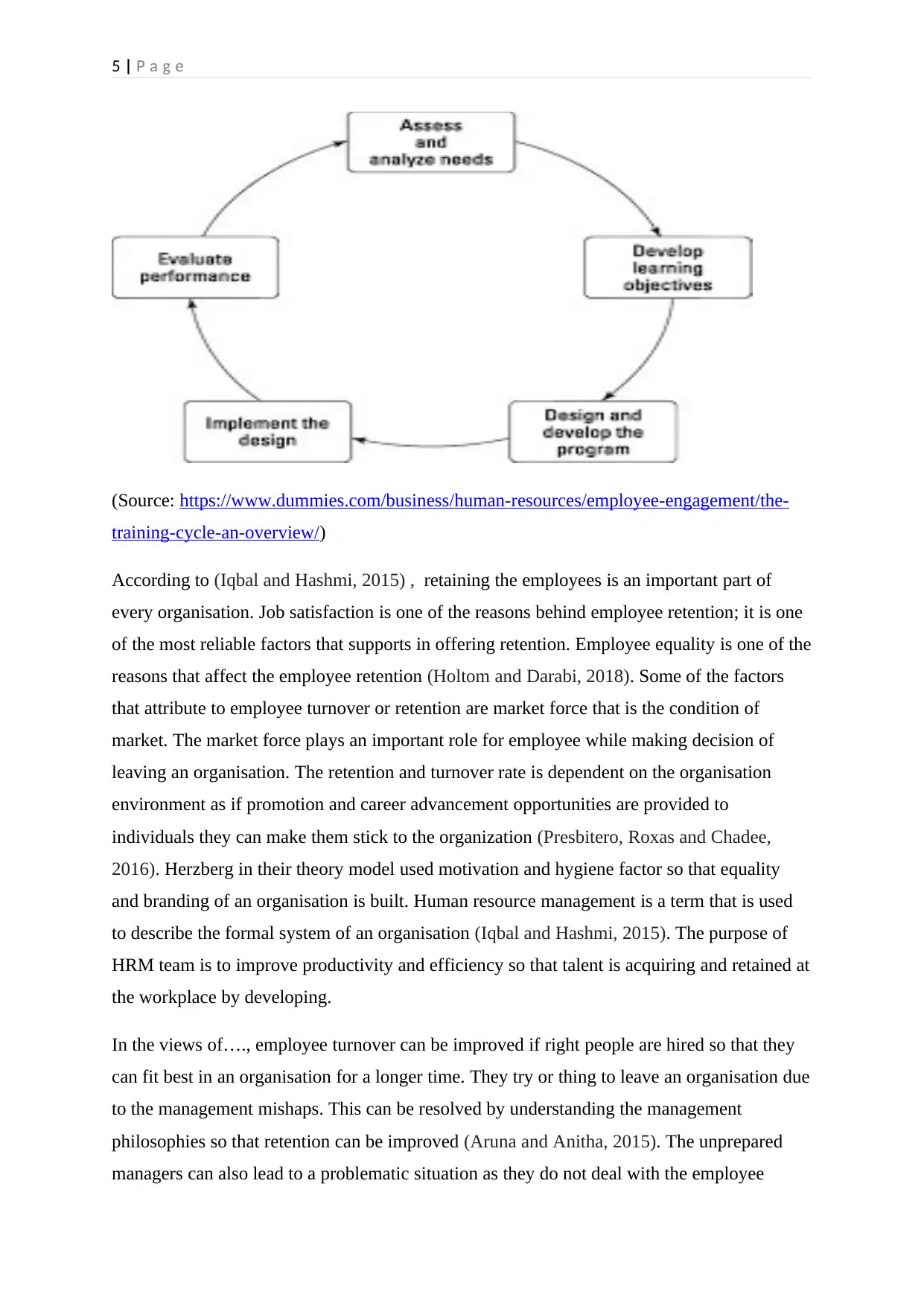
5 | P a g e
(Source: https://www.dummies.com/business/human-resources/employee-engagement/the-
training-cycle-an-overview/)
According to (Iqbal and Hashmi, 2015) , retaining the employees is an important part of
every organisation. Job satisfaction is one of the reasons behind employee retention; it is one
of the most reliable factors that supports in offering retention. Employee equality is one of the
reasons that affect the employee retention (Holtom and Darabi, 2018). Some of the factors
that attribute to employee turnover or retention are market force that is the condition of
market. The market force plays an important role for employee while making decision of
leaving an organisation. The retention and turnover rate is dependent on the organisation
environment as if promotion and career advancement opportunities are provided to
individuals they can make them stick to the organization (Presbitero, Roxas and Chadee,
2016). Herzberg in their theory model used motivation and hygiene factor so that equality
and branding of an organisation is built. Human resource management is a term that is used
to describe the formal system of an organisation (Iqbal and Hashmi, 2015). The purpose of
HRM team is to improve productivity and efficiency so that talent is acquiring and retained at
the workplace by developing.
In the views of…., employee turnover can be improved if right people are hired so that they
can fit best in an organisation for a longer time. They try or thing to leave an organisation due
to the management mishaps. This can be resolved by understanding the management
philosophies so that retention can be improved (Aruna and Anitha, 2015). The unprepared
managers can also lead to a problematic situation as they do not deal with the employee
(Source: https://www.dummies.com/business/human-resources/employee-engagement/the-
training-cycle-an-overview/)
According to (Iqbal and Hashmi, 2015) , retaining the employees is an important part of
every organisation. Job satisfaction is one of the reasons behind employee retention; it is one
of the most reliable factors that supports in offering retention. Employee equality is one of the
reasons that affect the employee retention (Holtom and Darabi, 2018). Some of the factors
that attribute to employee turnover or retention are market force that is the condition of
market. The market force plays an important role for employee while making decision of
leaving an organisation. The retention and turnover rate is dependent on the organisation
environment as if promotion and career advancement opportunities are provided to
individuals they can make them stick to the organization (Presbitero, Roxas and Chadee,
2016). Herzberg in their theory model used motivation and hygiene factor so that equality
and branding of an organisation is built. Human resource management is a term that is used
to describe the formal system of an organisation (Iqbal and Hashmi, 2015). The purpose of
HRM team is to improve productivity and efficiency so that talent is acquiring and retained at
the workplace by developing.
In the views of…., employee turnover can be improved if right people are hired so that they
can fit best in an organisation for a longer time. They try or thing to leave an organisation due
to the management mishaps. This can be resolved by understanding the management
philosophies so that retention can be improved (Aruna and Anitha, 2015). The unprepared
managers can also lead to a problematic situation as they do not deal with the employee
⊘ This is a preview!⊘
Do you want full access?
Subscribe today to unlock all pages.

Trusted by 1+ million students worldwide
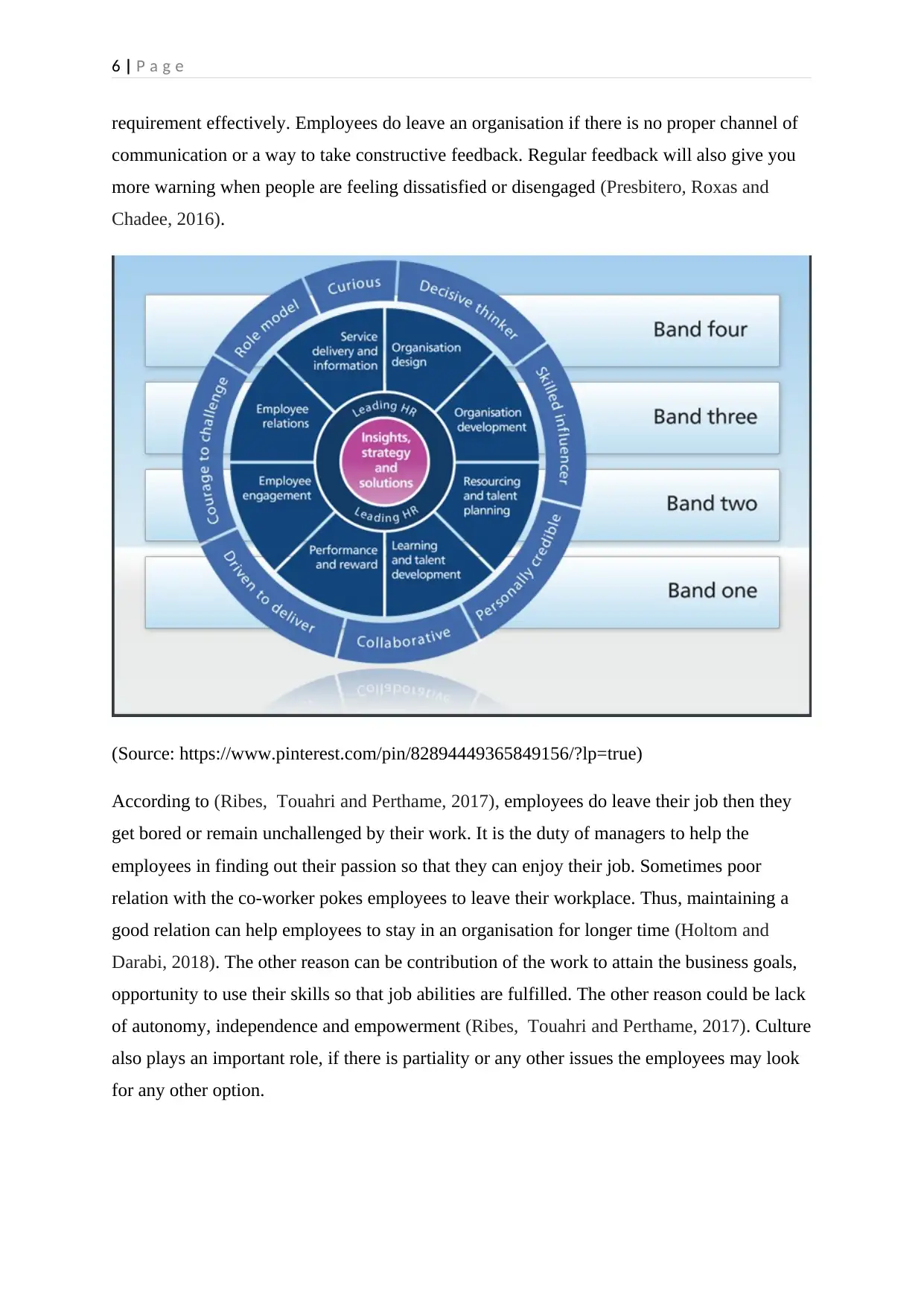
6 | P a g e
requirement effectively. Employees do leave an organisation if there is no proper channel of
communication or a way to take constructive feedback. Regular feedback will also give you
more warning when people are feeling dissatisfied or disengaged (Presbitero, Roxas and
Chadee, 2016).
(Source: https://www.pinterest.com/pin/82894449365849156/?lp=true)
According to (Ribes, Touahri and Perthame, 2017), employees do leave their job then they
get bored or remain unchallenged by their work. It is the duty of managers to help the
employees in finding out their passion so that they can enjoy their job. Sometimes poor
relation with the co-worker pokes employees to leave their workplace. Thus, maintaining a
good relation can help employees to stay in an organisation for longer time (Holtom and
Darabi, 2018). The other reason can be contribution of the work to attain the business goals,
opportunity to use their skills so that job abilities are fulfilled. The other reason could be lack
of autonomy, independence and empowerment (Ribes, Touahri and Perthame, 2017). Culture
also plays an important role, if there is partiality or any other issues the employees may look
for any other option.
requirement effectively. Employees do leave an organisation if there is no proper channel of
communication or a way to take constructive feedback. Regular feedback will also give you
more warning when people are feeling dissatisfied or disengaged (Presbitero, Roxas and
Chadee, 2016).
(Source: https://www.pinterest.com/pin/82894449365849156/?lp=true)
According to (Ribes, Touahri and Perthame, 2017), employees do leave their job then they
get bored or remain unchallenged by their work. It is the duty of managers to help the
employees in finding out their passion so that they can enjoy their job. Sometimes poor
relation with the co-worker pokes employees to leave their workplace. Thus, maintaining a
good relation can help employees to stay in an organisation for longer time (Holtom and
Darabi, 2018). The other reason can be contribution of the work to attain the business goals,
opportunity to use their skills so that job abilities are fulfilled. The other reason could be lack
of autonomy, independence and empowerment (Ribes, Touahri and Perthame, 2017). Culture
also plays an important role, if there is partiality or any other issues the employees may look
for any other option.
Paraphrase This Document
Need a fresh take? Get an instant paraphrase of this document with our AI Paraphraser
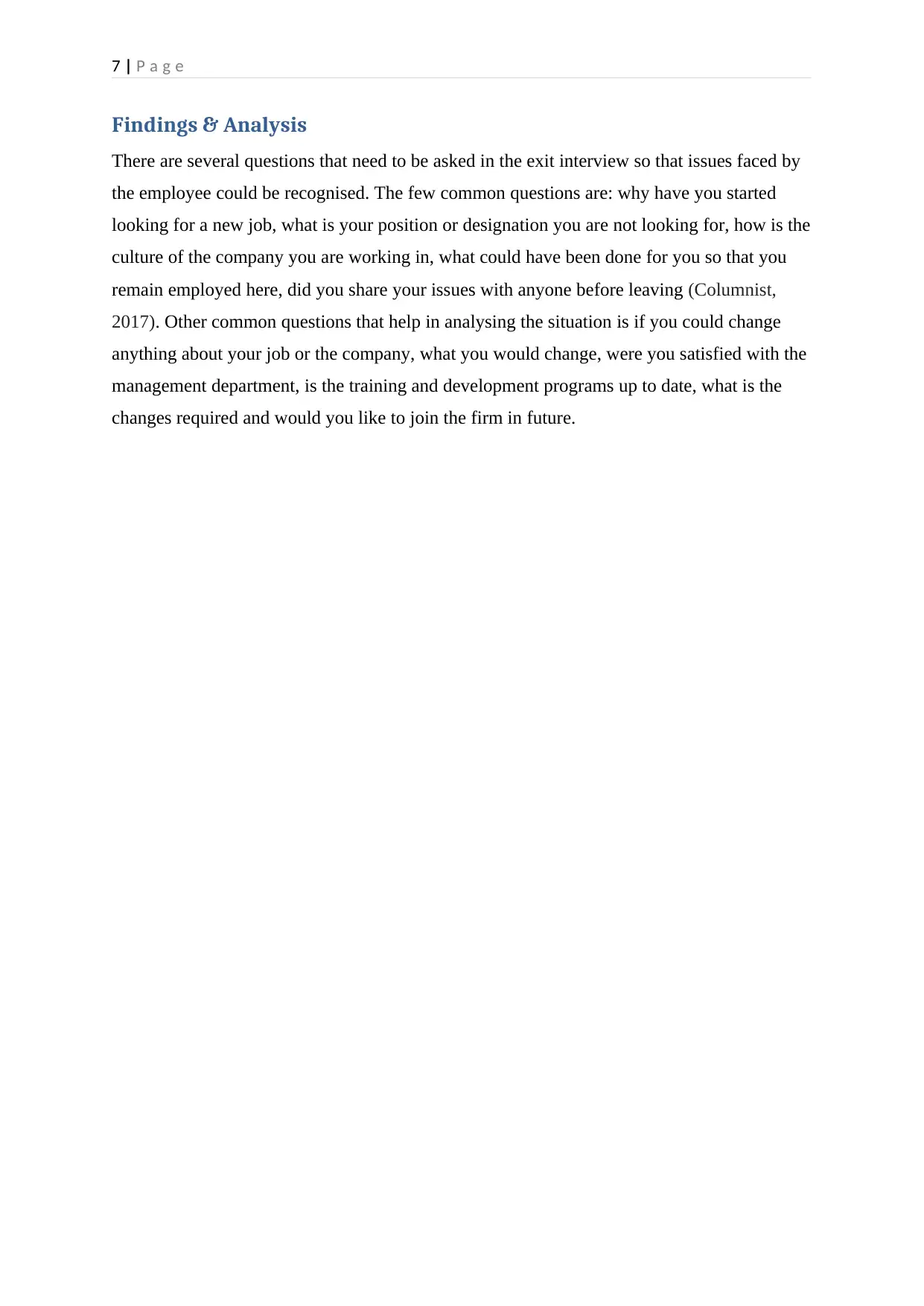
7 | P a g e
Findings & Analysis
There are several questions that need to be asked in the exit interview so that issues faced by
the employee could be recognised. The few common questions are: why have you started
looking for a new job, what is your position or designation you are not looking for, how is the
culture of the company you are working in, what could have been done for you so that you
remain employed here, did you share your issues with anyone before leaving (Columnist,
2017). Other common questions that help in analysing the situation is if you could change
anything about your job or the company, what you would change, were you satisfied with the
management department, is the training and development programs up to date, what is the
changes required and would you like to join the firm in future.
Findings & Analysis
There are several questions that need to be asked in the exit interview so that issues faced by
the employee could be recognised. The few common questions are: why have you started
looking for a new job, what is your position or designation you are not looking for, how is the
culture of the company you are working in, what could have been done for you so that you
remain employed here, did you share your issues with anyone before leaving (Columnist,
2017). Other common questions that help in analysing the situation is if you could change
anything about your job or the company, what you would change, were you satisfied with the
management department, is the training and development programs up to date, what is the
changes required and would you like to join the firm in future.
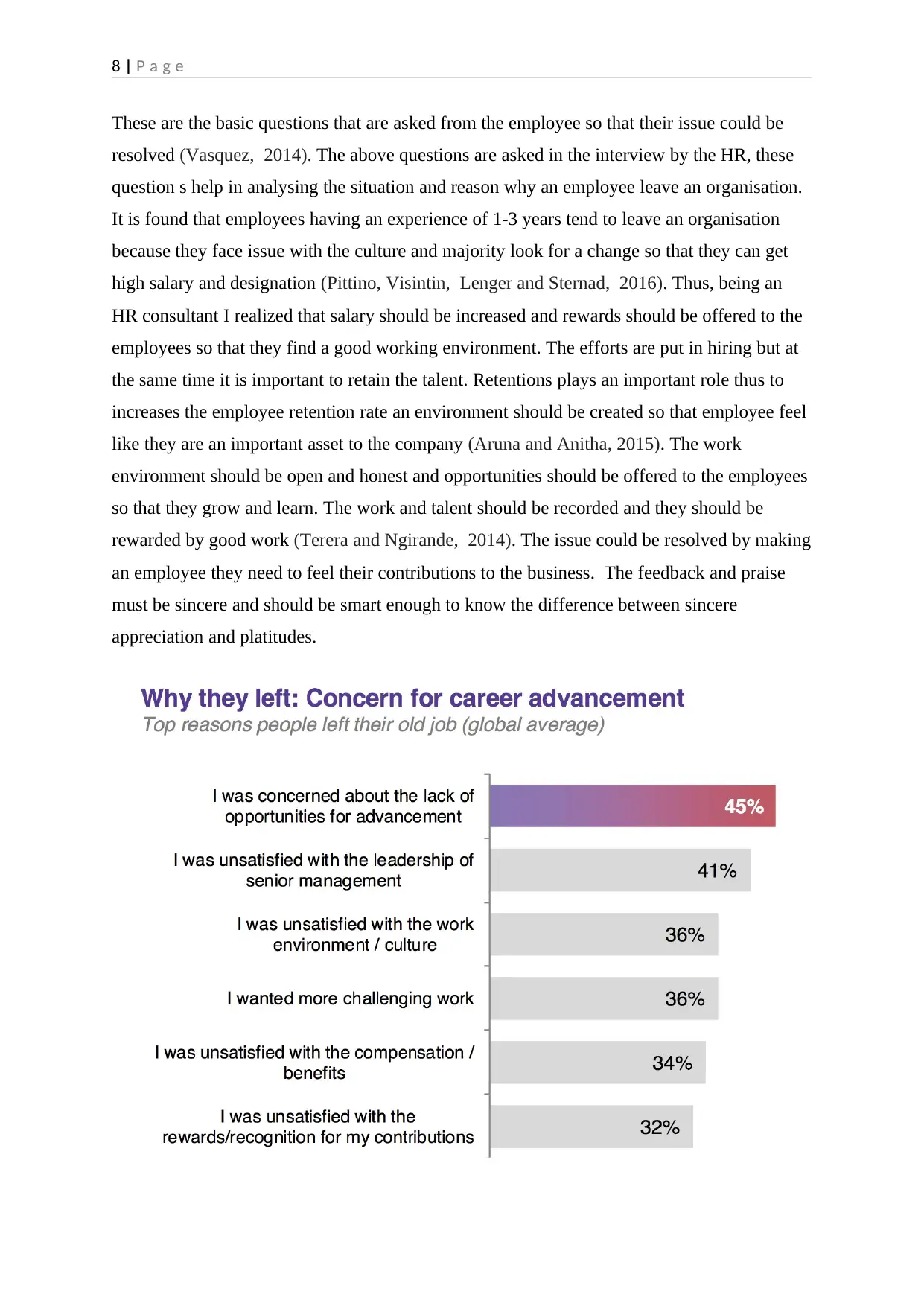
8 | P a g e
These are the basic questions that are asked from the employee so that their issue could be
resolved (Vasquez, 2014). The above questions are asked in the interview by the HR, these
question s help in analysing the situation and reason why an employee leave an organisation.
It is found that employees having an experience of 1-3 years tend to leave an organisation
because they face issue with the culture and majority look for a change so that they can get
high salary and designation (Pittino, Visintin, Lenger and Sternad, 2016). Thus, being an
HR consultant I realized that salary should be increased and rewards should be offered to the
employees so that they find a good working environment. The efforts are put in hiring but at
the same time it is important to retain the talent. Retentions plays an important role thus to
increases the employee retention rate an environment should be created so that employee feel
like they are an important asset to the company (Aruna and Anitha, 2015). The work
environment should be open and honest and opportunities should be offered to the employees
so that they grow and learn. The work and talent should be recorded and they should be
rewarded by good work (Terera and Ngirande, 2014). The issue could be resolved by making
an employee they need to feel their contributions to the business. The feedback and praise
must be sincere and should be smart enough to know the difference between sincere
appreciation and platitudes.
These are the basic questions that are asked from the employee so that their issue could be
resolved (Vasquez, 2014). The above questions are asked in the interview by the HR, these
question s help in analysing the situation and reason why an employee leave an organisation.
It is found that employees having an experience of 1-3 years tend to leave an organisation
because they face issue with the culture and majority look for a change so that they can get
high salary and designation (Pittino, Visintin, Lenger and Sternad, 2016). Thus, being an
HR consultant I realized that salary should be increased and rewards should be offered to the
employees so that they find a good working environment. The efforts are put in hiring but at
the same time it is important to retain the talent. Retentions plays an important role thus to
increases the employee retention rate an environment should be created so that employee feel
like they are an important asset to the company (Aruna and Anitha, 2015). The work
environment should be open and honest and opportunities should be offered to the employees
so that they grow and learn. The work and talent should be recorded and they should be
rewarded by good work (Terera and Ngirande, 2014). The issue could be resolved by making
an employee they need to feel their contributions to the business. The feedback and praise
must be sincere and should be smart enough to know the difference between sincere
appreciation and platitudes.
⊘ This is a preview!⊘
Do you want full access?
Subscribe today to unlock all pages.

Trusted by 1+ million students worldwide
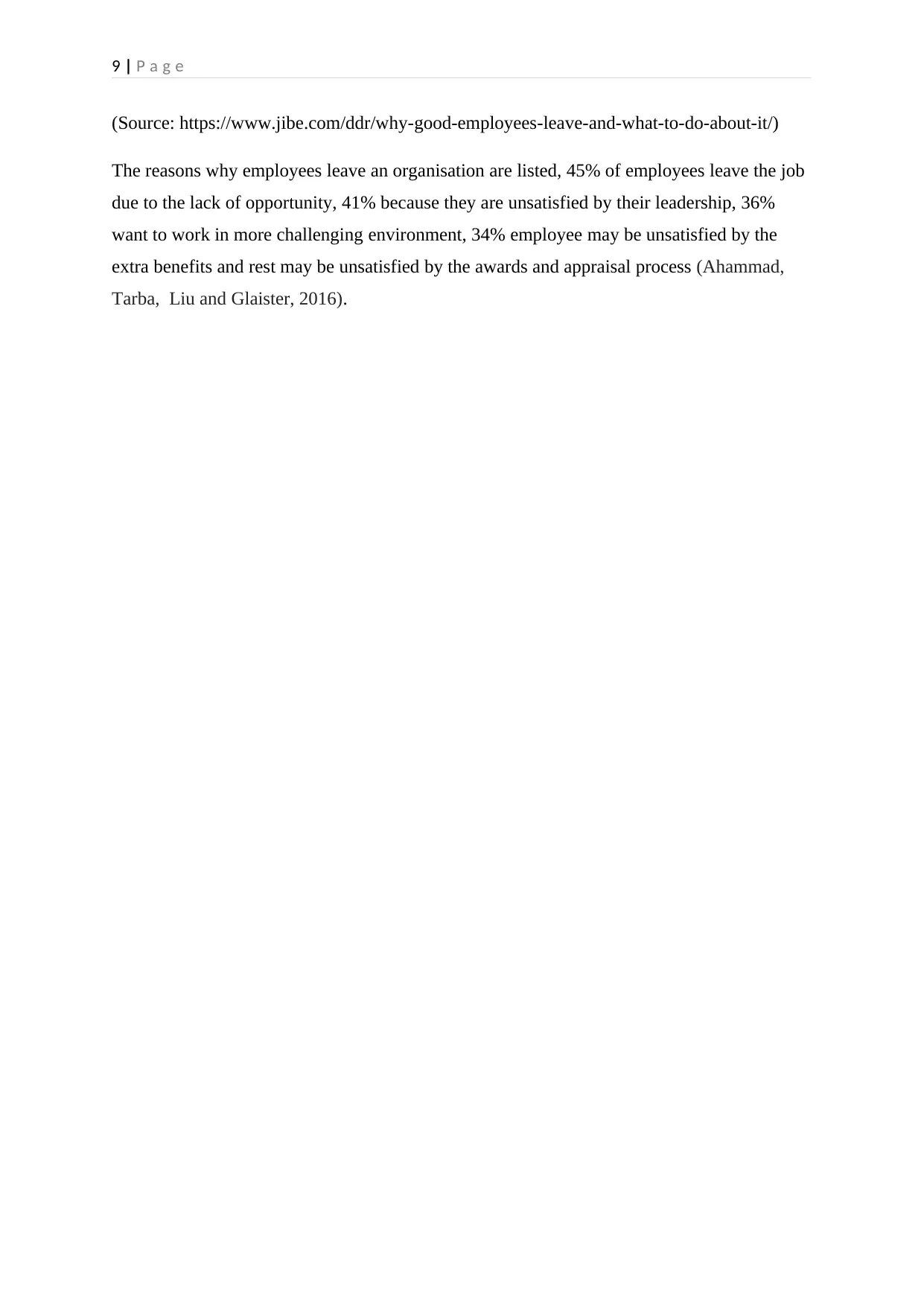
9 | P a g e
(Source: https://www.jibe.com/ddr/why-good-employees-leave-and-what-to-do-about-it/)
The reasons why employees leave an organisation are listed, 45% of employees leave the job
due to the lack of opportunity, 41% because they are unsatisfied by their leadership, 36%
want to work in more challenging environment, 34% employee may be unsatisfied by the
extra benefits and rest may be unsatisfied by the awards and appraisal process (Ahammad,
Tarba, Liu and Glaister, 2016).
(Source: https://www.jibe.com/ddr/why-good-employees-leave-and-what-to-do-about-it/)
The reasons why employees leave an organisation are listed, 45% of employees leave the job
due to the lack of opportunity, 41% because they are unsatisfied by their leadership, 36%
want to work in more challenging environment, 34% employee may be unsatisfied by the
extra benefits and rest may be unsatisfied by the awards and appraisal process (Ahammad,
Tarba, Liu and Glaister, 2016).
Paraphrase This Document
Need a fresh take? Get an instant paraphrase of this document with our AI Paraphraser
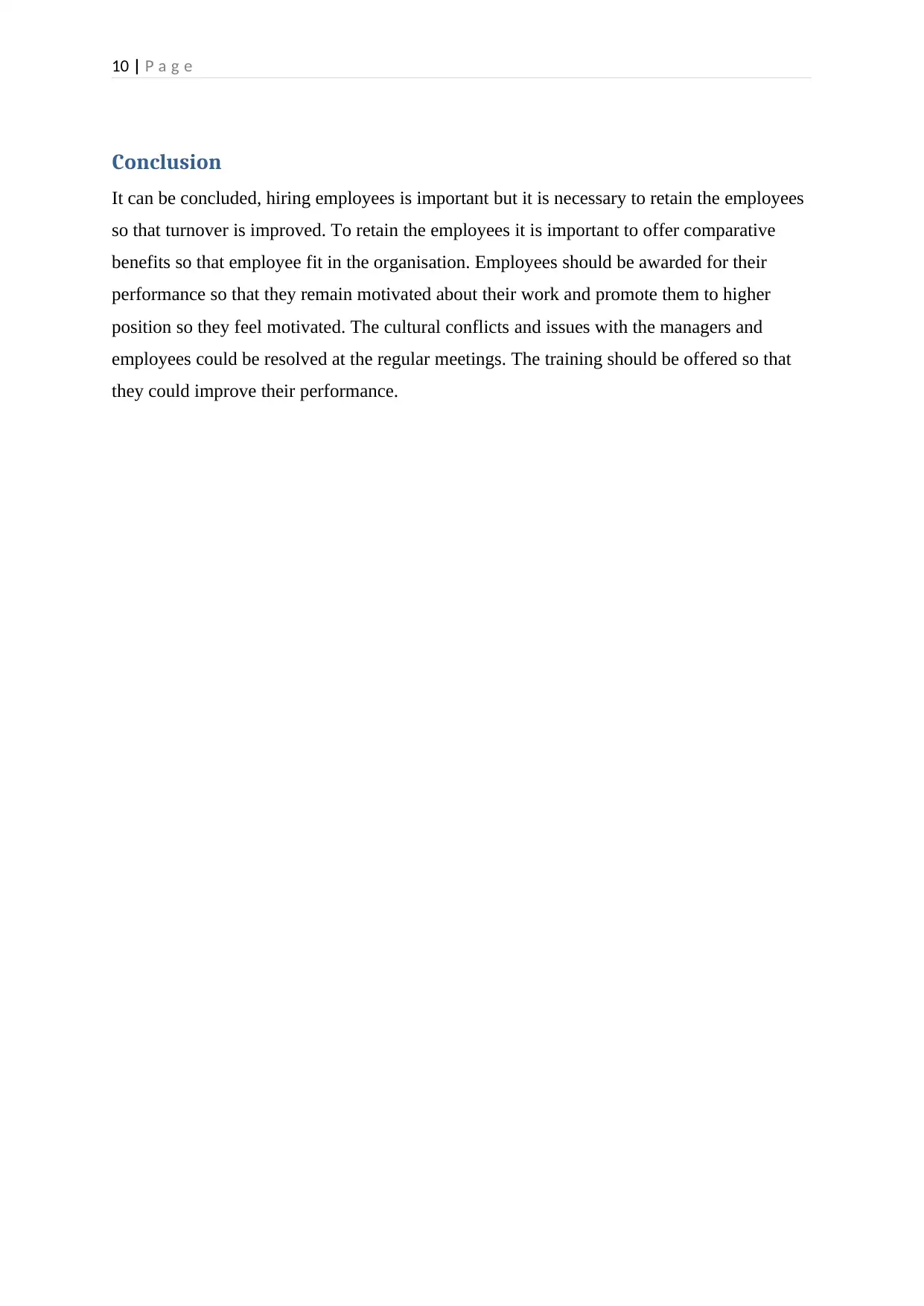
10 | P a g e
Conclusion
It can be concluded, hiring employees is important but it is necessary to retain the employees
so that turnover is improved. To retain the employees it is important to offer comparative
benefits so that employee fit in the organisation. Employees should be awarded for their
performance so that they remain motivated about their work and promote them to higher
position so they feel motivated. The cultural conflicts and issues with the managers and
employees could be resolved at the regular meetings. The training should be offered so that
they could improve their performance.
Conclusion
It can be concluded, hiring employees is important but it is necessary to retain the employees
so that turnover is improved. To retain the employees it is important to offer comparative
benefits so that employee fit in the organisation. Employees should be awarded for their
performance so that they remain motivated about their work and promote them to higher
position so they feel motivated. The cultural conflicts and issues with the managers and
employees could be resolved at the regular meetings. The training should be offered so that
they could improve their performance.
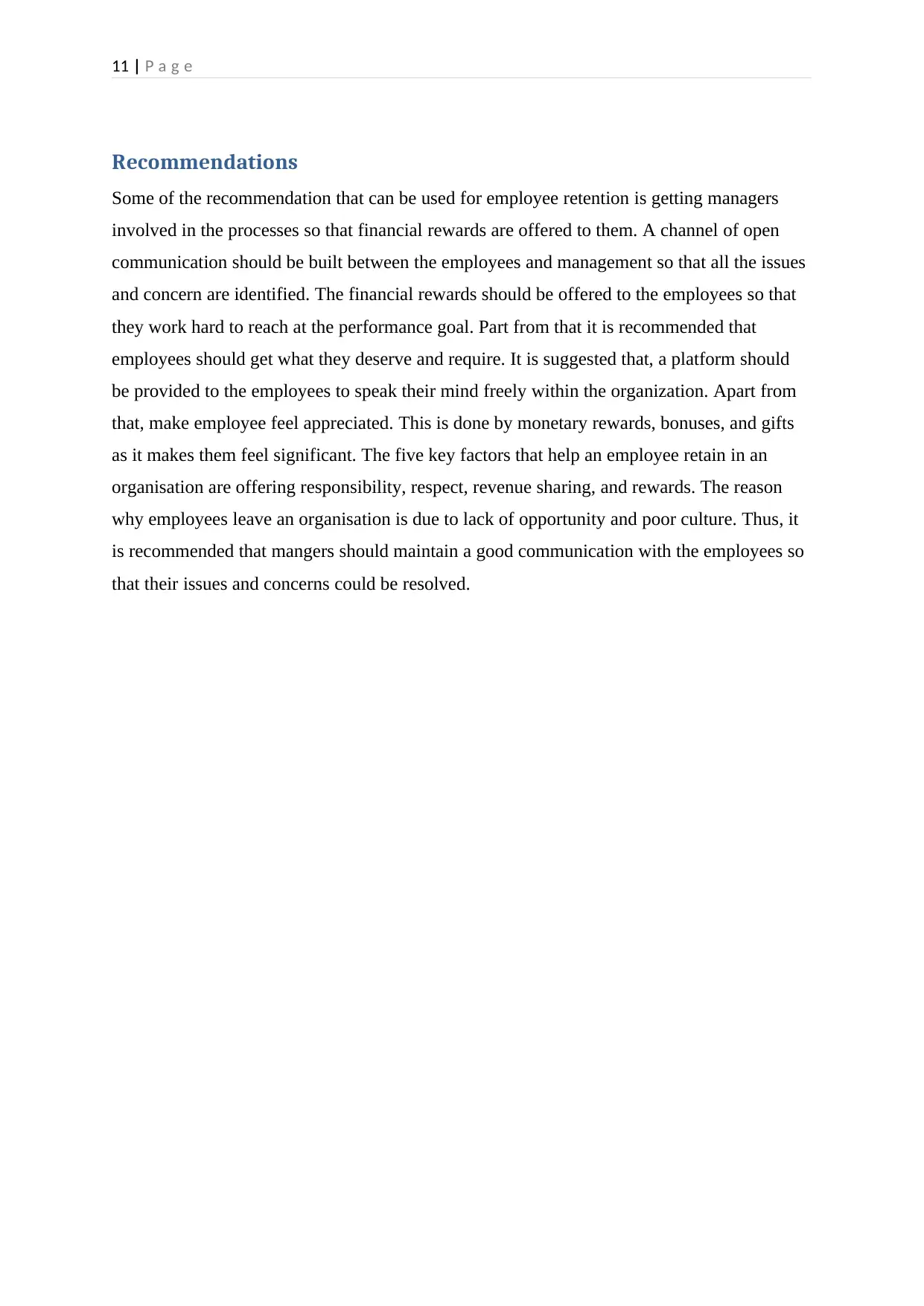
11 | P a g e
Recommendations
Some of the recommendation that can be used for employee retention is getting managers
involved in the processes so that financial rewards are offered to them. A channel of open
communication should be built between the employees and management so that all the issues
and concern are identified. The financial rewards should be offered to the employees so that
they work hard to reach at the performance goal. Part from that it is recommended that
employees should get what they deserve and require. It is suggested that, a platform should
be provided to the employees to speak their mind freely within the organization. Apart from
that, make employee feel appreciated. This is done by monetary rewards, bonuses, and gifts
as it makes them feel significant. The five key factors that help an employee retain in an
organisation are offering responsibility, respect, revenue sharing, and rewards. The reason
why employees leave an organisation is due to lack of opportunity and poor culture. Thus, it
is recommended that mangers should maintain a good communication with the employees so
that their issues and concerns could be resolved.
Recommendations
Some of the recommendation that can be used for employee retention is getting managers
involved in the processes so that financial rewards are offered to them. A channel of open
communication should be built between the employees and management so that all the issues
and concern are identified. The financial rewards should be offered to the employees so that
they work hard to reach at the performance goal. Part from that it is recommended that
employees should get what they deserve and require. It is suggested that, a platform should
be provided to the employees to speak their mind freely within the organization. Apart from
that, make employee feel appreciated. This is done by monetary rewards, bonuses, and gifts
as it makes them feel significant. The five key factors that help an employee retain in an
organisation are offering responsibility, respect, revenue sharing, and rewards. The reason
why employees leave an organisation is due to lack of opportunity and poor culture. Thus, it
is recommended that mangers should maintain a good communication with the employees so
that their issues and concerns could be resolved.
⊘ This is a preview!⊘
Do you want full access?
Subscribe today to unlock all pages.

Trusted by 1+ million students worldwide
1 out of 17
Related Documents
Your All-in-One AI-Powered Toolkit for Academic Success.
+13062052269
info@desklib.com
Available 24*7 on WhatsApp / Email
![[object Object]](/_next/static/media/star-bottom.7253800d.svg)
Unlock your academic potential
Copyright © 2020–2025 A2Z Services. All Rights Reserved. Developed and managed by ZUCOL.





